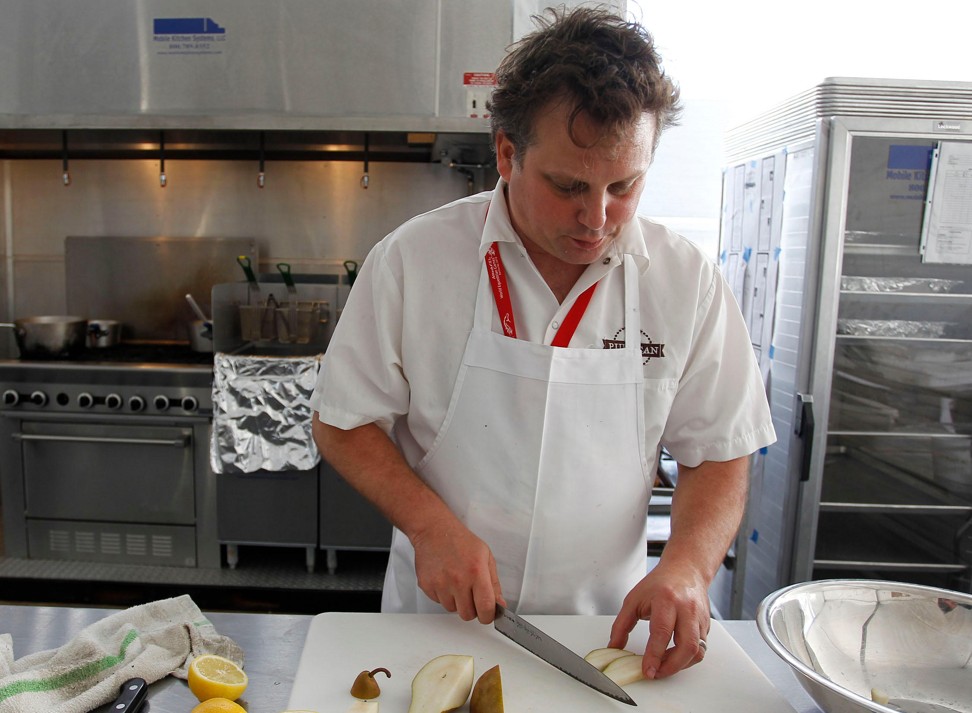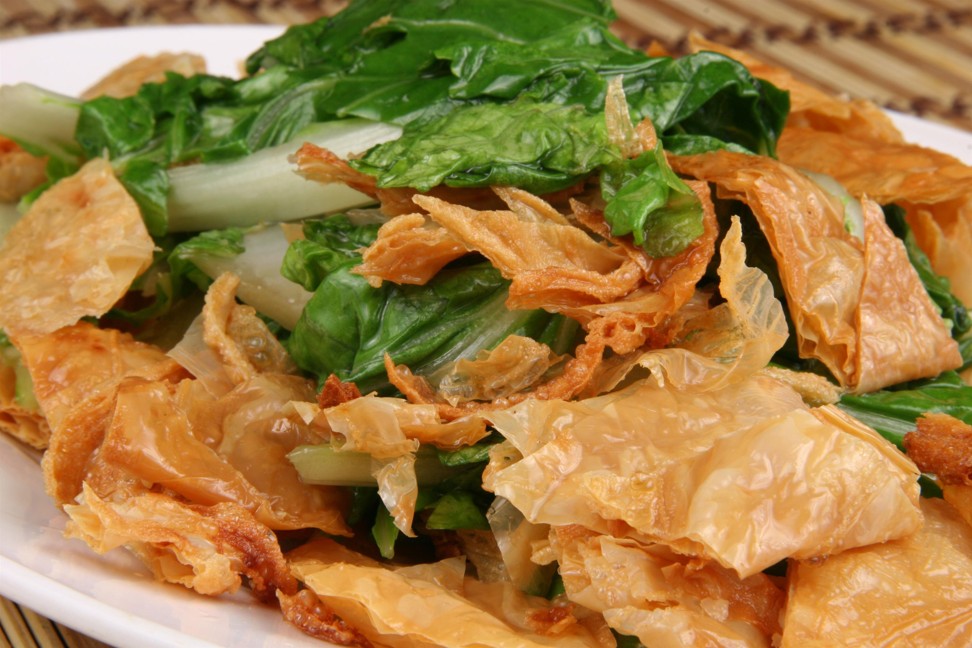
The chefs who’ve made cabbage cool: how lowly vegetable became trendy and finally got its due
- Kimchi, sauerkraut, coleslaw, bubble and squeak, Buddha’s delight – fried, stuffed, sautéed, raw or preserved, cabbage is a staple food in much of the world
- It’s long been seen as a cheap, everyday food, but young chefs rave about its versatility and texture and are using it in surprising ways and pairings

Here’s a sentence that might come as a surprise: cabbage is cool. That taken-for-granted vegetable, that sturdy, dense staple of many a poor, ancestral homeland, is finally getting respect.
“It’s all about how it is prepared, how it’s elevated,” says Paul Kahan, a James Beard award-winning chef in Chicago and self-professed cabbage freak.
He thinks that because cabbage has mainly been associated with sustenance, it has not been given its due.
Cabbage is part of most of the world’s cooking history. Perhaps most famously, it was one of the only sources of sustenance in famine-ravaged Ireland in the mid-19th century. Thus the classic Irish dish corned beef and cabbage, not to mention colcannon.

In China, there’s cabbage sautéed with bean curd. In England, cabbage cooked with potatoes and other vegetables in bubble and squeak. In Norway, the hot and sour surkal. In the US, coleslaw. Fermented and pickled cabbage dishes abound, including kimchi in Korea, and sauerkraut in Poland, Germany and other parts of middle and Eastern Europe. Stuffed cabbage rolls are part of just about every cuisine, form golabki in Poland to holishkes in Jewish cooking to sarma in Croatia.
There’s more, but the point is: in all times and places, cabbage has been valued for its plenteousness, cheapness, long shelf life, and ability to be preserved for an even longer shelf life. It can be eaten raw or cooked in pretty much any way a vegetable can be cooked.

Now, it’s also trendy. “It’s just delicious,” says Kahan.
He has been on the cabbage bandwagon for years, serving it at his upscale Chicago restaurants in various guises. At Publican, they char wedges of cabbage in a wood-burning hearth and then finish them in a pan with butter and shallots. Kahan remembers being inspired by a dish made by New Orleans chef Alon Shaya: “It was the first time I ever saw a chunk of cabbage served at a restaurant.”
And that is how kitchen trends start – chefs get inspired, borrowing from other restaurants and other cultures; food publications take their cues from the chefs; and suddenly, cabbage recipes proliferate.

Robert Schueller, the “produce guru” at Melissa’s Produce, a speciality company in Los Angeles in the US, says chefs and restaurants are the clear drivers behind the cabbage movement. Cabbage is being used as everything from a taco topping (common in Mexico) to a base or nest for menu items such as marinated fish. Chefs like how cabbage maintains a crisper texture than other greens when served with warm foods, he says.
“We have seen a rise in Napa cabbage, too, which is used in Asian stir fries, fermentation and pickling, all of which are gaining in popularity. The most interesting thing is that the rise of Napa is not just in Asian groceries and restaurants,” Schueller says.
Gabriel Kreuther gets creative with cabbage at his eponymous restaurant in New York. He purées well-cooked cabbage as a base for some garnishes; uses it in a side dish with trumpet mushrooms warmed in duck fat; and serves up a simple slaw of shredded cabbage, onion, oil, vinegar, and salt and pepper, maybe with some julienned gruyere cheese mixed in.

“It goes with everything; it’s refreshing, it gets better with a few days macerating time, it’s soft and crunchy, it’s healthy,” Kreuther says.
At the restaurant, they make their own sauerkraut, a dish he grew up with in his native Alsace region of France. Kreuther serves the sauerkraut in a smoked sturgeon; his sauerkraut tartlet topped with caviar mousseline is in a filo pastry shell and served under a wine glass filled with smoke.
Kreuther likes mixing poor man’s food with luxury ingredients and seeing how they play against each other. That explains another dish on his menu: layers of squab breast and foie gras wrapped with cabbage leaves, and then encased in Tunisian brik dough and seared until the outside is crispy.
And how do people react when they see cabbage on this highbrow menu?
“People pooh-pooh cabbage,” he says, “but when they taste it well prepared they say, ‘Oh, I didn’t realise cabbage could be so delicious!’”
Three cabbage recipes

1. Stuffed cabbage leaves
16-20 large leaves of savoy cabbage, plus extra for covering the rolls
40ml cooking oil
1 medium-sized onion, diced
2 large garlic cloves, minced
3/4 tsp cumin seeds
1 medium-sized carrot, peeled and diced
500 grams minced beef (or use half beef and half pork)
100 grams uncooked long-grain rice
30 grams tomato paste
Fine sea salt and freshly ground black pepper
For the sauce:
15ml cooking oil
1/2 a medium-sized onion, diced
2 large garlic cloves, minced
750 grams canned diced tomatoes
30ml aged balsamic vinegar

1. Bring a large pot of salted water to a simmer, add the cabbage leaves and cook for about 30 seconds, or until they wilt. Drain the leaves, rinse in cold water, then drain again. Squeeze as much water as possible from the leaves then dry them with paper towels. Use a sharp paring knife to cut out the thick parts of the veins.
2. To make the tomato sauce, heat the cooking oil in a pan, then add the onion and garlic and cook until soft. Stir in the tomato, season with salt and bring to the boil. Reduce the heat and simmer for about 30 minutes. Stir in the balsamic vinegar.
3. For the filling, heat the cooking oil in a skillet, add the onion and garlic and cook until soft. Add the cumin seeds and cook for about 30 seconds, stirring constantly. Add the carrot and cook until tender. Cool completely, then mix with the meat, rice, tomato paste and salt and pepper to taste.
4. Preheat the oven to 180 degrees. Spoon some of the tomato sauce into a baking dish.
5. Lay a cabbage leaf on the work surface. If the leaf was trimmed of the vein, overlap the cut edges slightly. Spoon some of the filling over the leaf on the side closest to you. Fold the bottom and sides over the filling, then roll it into a parcel. Place the roll seam-side down in the baking dish then continue with the remaining leaves and filling. Place some cabbage leaves on top. Cover the pan with the lid then bake for about one hour. Cool for about 15 minutes before serving.

2. Japanese beef cubes with fried garlic and shredded cabbage
400-500 grams beef steak, about 2cm thick
4 garlic cloves
Fine sea salt
Oil, for pan-frying
For the sauce:
30ml soy sauce
20ml sake
10 grams sugar
10ml sesame oil
For serving:
Steamed Japanese rice
¼ of a green head cabbage, preferably Japanese
Kewpie mayonnaise
Shichimi togarashi and furikake, for sprinkling

1. Cut the beef into 2cm cubes, sprinkle them lightly with salt and mix well. Set this aside while preparing the other ingredients. Thinly slice the garlic cloves. Lightly oil a skillet (preferably un-enamelled cast iron) and place it over a medium-low flame. Scatter the sliced garlic into the pan and use chopsticks (or small tongs) to place the pieces in one layer. Cook the garlic until pale golden on one side, then turn the slices over and brown the other side. Do not let the garlic get too dark, or the flavour will be bitter, and adjust the flame under the pan as needed so the pieces do not cook too quickly. When the garlic is pale golden and crisp, remove the slices from the skillet.
2. Thinly slice the cabbage and divide between two serving plates. Put all the ingredients for the sauce in a small saucepan and place it over a medium flame. Bring to the boil then lower the heat and cook at a low simmer until the ingredients reduce to a light sauce consistency. Turn off the flame.
3. Place the skillet used to cook the garlic over a medium-high flame (no need to wash the pan). Lightly oil the skillet and when the oil is hot, add the cubes of meat. Sear the meat, turning the pieces over so they brown on all sides, cooking them quickly so they do not become overdone.
4. Divide the meat between the two serving plates. Quickly re-heat the sauce, bringing it to a simmer. Drizzle the sauce over the beef cubes, then scatter the garlic slices on top. Squirt a blob of kewpie mayonnaise on the plate and dust it lightly with shichimi togarashi. Serve the meat and cabbage with a bowl of steamed Japanese rice that is been sprinkled with furikake. Serve immediately.

3. Cabbage kimchi
Half a large head of Korean, Japanese or Chinese cabbage, about 1kg
About 50 grams fine sea salt
35 grams glutinous rice flour
50 grams granulated sugar
100 grams gochugaru (or more or less, to taste)
100ml Korean salted anchovy sauce
100 grams Korean salted shrimp, drained and chopped
40 grams garlic, minced
20 grams grated ginger
Optional ingredients (enough to go with half a head of cabbage):
150 grams white radish, peeled, then sliced into matchsticks
8-10 spring onions, cut into 2cm-3cm lengths
20 flat Chinese chives, sliced into 2cm-3cm lengths
About 75 grams carrot, peeled, then sliced into matchsticks
Half a Korean pear, peeled, then sliced into matchsticks

1. Place the cabbage on a cutting board and make a cut about 4cm long through the stem end. Tear the cabbage into two pieces and remove the core. Cut the leaves into pieces that are about the same size. Put the leaves in a colander, rinse thoroughly with running water, then put the cabbage into a large bowl (or you may need two). Sprinkle salt thoroughly over the cabbage and use your hands to mix. Leave for at least four hours, mixing frequently, until the leaves are completely wilted and soft. Drain off as much liquid as possible from the leaves, then cover them with plenty of water. Rinse the cabbage well, then pour off the water and squeeze the leaves tightly between your hands. Put the cabbage back in the bowl, add fresh water and repeat the process. Taste several pieces of cabbage – they shouldn't be too salty. If the cabbage is very salty, repeat the washing and draining process. Squeeze out as much liquid as possible from the leaves.
2. Pour 240ml of water into a saucepan, add the glutinous rice flour and whisk until smooth. Place the pan over a low flame and cook, stirring constantly, until the mixture is translucent, then stir in the sugar. Cool the mixture to room temperature then mix in the gochugaru, anchovy sauce, salted shrimp, minced garlic and grated ginger.
3. Put the cabbage and any optional ingredients into a large bowl and add about one-third of the kimchi paste. Wearing a disposable glove on your working hand (this prevents the paste from staining your skin), mix the paste with the vegetables to coat them lightly. At this point, you can eat the kimchi fresh, as you would a salad.
4. For fermented kimchi, put it into a large glass jar and seal tightly. Leave the jar at room temperature for a few hours, or for several days (if you like a more fermented taste). Occasionally open the jar, to let any fermenting gases escape. Store the kimchi in the fridge. Remaining kimchi paste should be stored in a glass jar in the fridge; it keeps for several months.